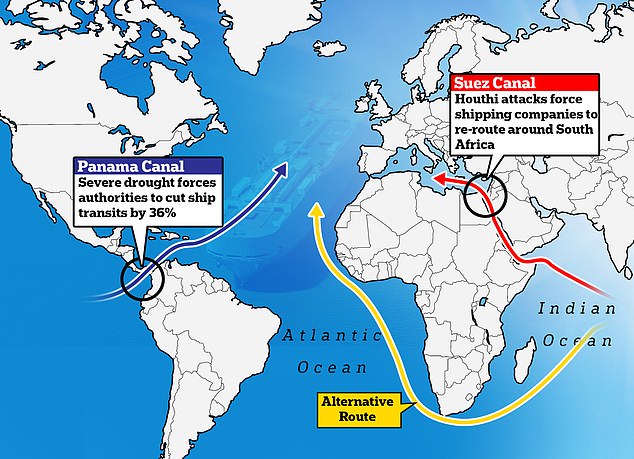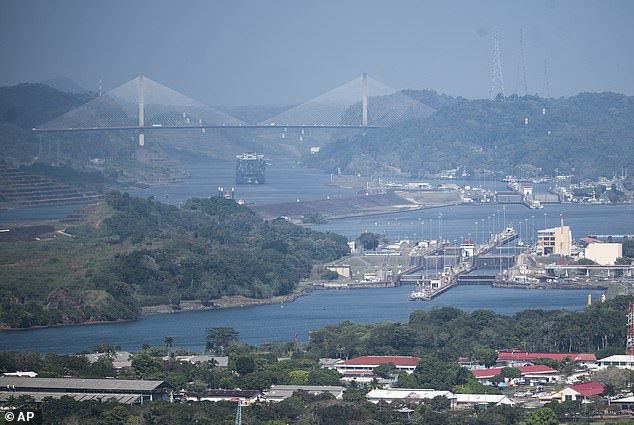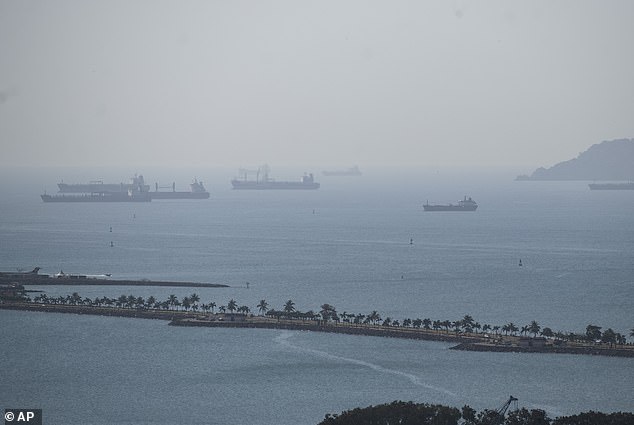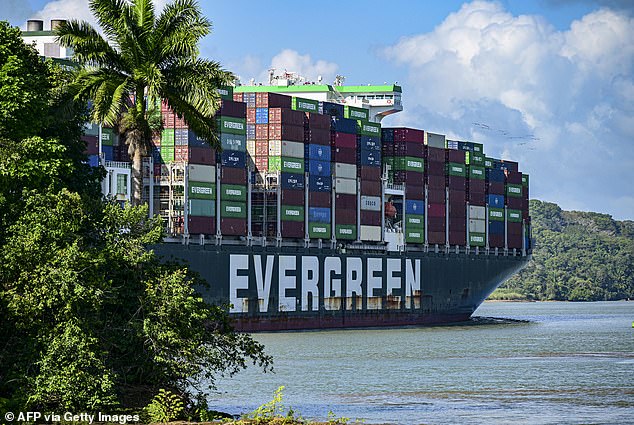Global trade faces even more turmoil as Panama Canal is forced to slash ship transits by more than a third due to drought – adding to chaos caused by Iran-backed Houthi rebels in Red Sea
Global trade is facing even more turmoil. The severe drought that began last year forced authorities to cut ship transit in the Panama Canal, one of the world’s most important trade routes, by 36%.
The new cuts announced by authorities in Panama on Wednesday will deliver an even bigger economic blow than previously expected, amid a crisis in the Red Sea that is already wreaking havoc on global trade between Asia and Europe.
The managers of the Panama Canal now estimate that falling water levels could cost them between £395 million and £551 million by 2024.
That compares with previous estimates of £157 million.
One of the worst droughts to ever hit the Central American country has caused chaos along the 50-mile maritime route.
Global trade is facing even more turmoil after a severe drought that began last year forced authorities to cut ship transit in the Panama Canal (seen on Wednesday as a ship passed through), one of the world’s most important trade routes, by 36% to decrease.

It has caused a traffic jam of boats, raising doubts about the canal’s reliability for international shipping and raising concerns about its impact on global trade.
On Wednesday, Ricaurte Vasquez, manager of the Panama Canal, said they would reduce the daily transit of ships to 24, after gradually reducing the transit of 38 ships per day in normal times last year.
“It is vital that the country sends the message that we are going to take this on and find a solution to this water problem,” Vasquez said.
Mr. Vasquez added that transit saw 20% less cargo and 791 fewer ships in the first quarter of the fiscal year than the same period the year before.
It was a “significant reduction” for the country, Vasquez said.
But the official said “more efficient” water management and an increase in rainfall in November have at least allowed them to ensure water levels are high enough to allow 24 ships to pass daily until the end of April, the start of the next rainy season. .
Canal authorities attributed the drought to the El Nino weather phenomenon and climate change, warning that it was urgent for Panama to seek new water sources for both the canal’s operations and human consumption.
The same lakes that fill the canal also provide water for more than 50% of the country with more than four million inhabitants.
“The water problem is a national problem, not just of the Channel,” Vasquez said. “We need to tackle this problem across the country.”
Meanwhile, attacks by the Iran-backed Houthi militia on ships in and around the Red Sea since November have slowed trade between Asia and Europe and alarmed major powers in an escalation of the war between Israel and Hamas terrorists in Gaza.

A cargo ship waits at the Centennial Bridge to pass through the locks of the Panama Canal, in Panama City, Wednesday, January 17, 2024. Canal operators now estimate that falling water levels could cost them between £395 million and £551 million by 2024.

One of the worst droughts to ever hit the Central American country has caused chaos along the 50-mile maritime route, while the Suez Canal in the Red Sea is in crisis.
The attacks target a route that carries about 15 percent of the world’s shipping traffic and serves as a vital conduit between Europe and Asia.
The alternative route around the Cape of Good Hope in South Africa can add 10 to 14 days to a voyage compared to the Red Sea and Suez Canal passage.
The crisis rippled through the business world, reviving concerns about stretched supply chains that emerged as activity picked up after the COVID-19 pandemic.
War-hit Ukraine said the situation had led to a slowdown in agricultural exports this month. Pepco Group, which owns the Poundland group of discount stores, warned that stock levels could be affected.
The diversion of a growing number of ships is changing refueling patterns and driving demand for bunker fuel used by ships in remote ports from Mauritius to South Africa and the Canary Islands.

The cargo ship Evergreen waits at the Miraflores locks on the Panama Canal on January 11
Denmark’s Maersk and other major shipping companies have ordered hundreds of commercial ships to stay away from the Red Sea, either sending them on the longer route around Africa or pausing them until the ships’ safety can be assured.
The attacks, as well as weather-related closures and standstills in Europe, caused congestion at several container terminals, Maersk told customers on Thursday.
Italian ports are concerned they are being bypassed as ships steer away from the main Mediterranean route.
According to maritime consultancy Drewry’s World Container Index, freight rates have more than doubled since early December, while insurance sources say war risk premiums for Red Sea shipments are also rising.
